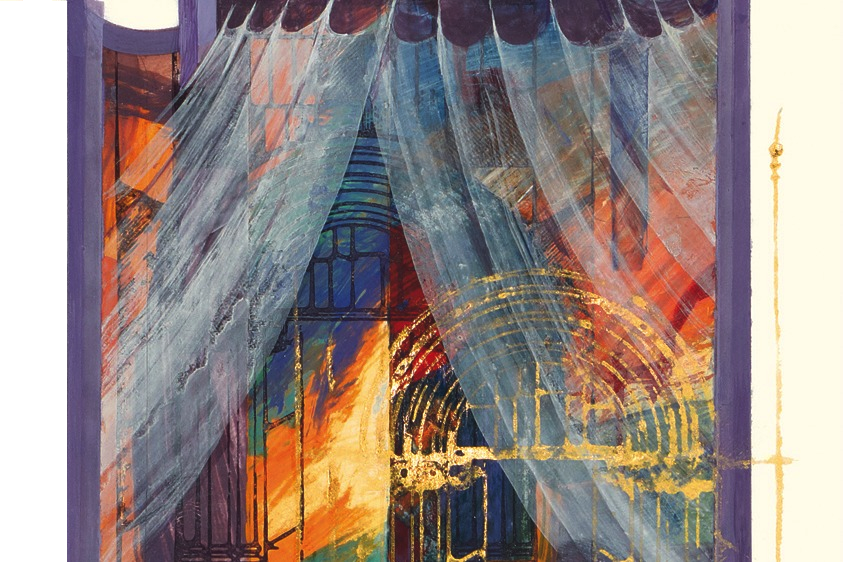A few years ago the McGrath Institute for Church Life welcomed Donald Jackson, the visionary calligrapher commissioned by St. John’s University in Collegeville to create a hand-written illuminated Bible using techniques that date back centuries. Jackson spoke on the process of planning, writing, and illuminating The Saint John’s Bible, a project which took 14 scribes and artists 16 years to complete. To put this into perspective, it took Michelangelo four years to paint the ceiling of the Sistine Chapel. The Saint John’s Bible is a massive undertaking, miraculous even, considering the daunting physical and artistic task of writing and illuminating the entire Bible, to say nothing of the financial cost. This begs the question: why write the Bible now? Why spend millions of dollars and hundreds of thousands of hours writing and illuminating texts that can be pulled up on a smartphone in seconds? What’s the point of The Saint John’s Bible?
The point is this:
The Word of God is living and active, sharper than any two-edged sword, piercing until it divides soul from spirit, joints from marrow; it is able to judge the thoughts and intentions of the heart. (Heb 4:12)
This is no mere text we read. Rather, as Dei Verbum reminds us so beautifully:
In the sacred books, the Father who is in heaven meets his children with great love and speaks to them; and the force and power in the Word of God is so great that it stands as the support and energy of the Church, the strength of faith for her [children], the food of the soul, the pure and everlasting source of spiritual life. (§21)
We encounter God in Scripture. God, who comes to meet us out of the unfathomable depths of love and the desire to be in relationship with us. And The Saint John’s Bible provides a beautiful point of entry for that encounter, that relationship.
Seen in this illuminated light, the scribes, artists, and committee members responsible for the creation of The Saint John’s Bible—like the medieval scribes centuries ago—were not merely creating a work of art for its own sake. Rather, they were performing a radical act of evangelization, bringing the Word of God to a new generation in ways “ever ancient and ever new” (to borrow from Augustine) by using “ancient techniques in a modern world” (to quote the title of Jackson’s upcoming lecture). The scribes themselves made every quill. They mixed vibrant colors using ink sticks that were nearly 150 years old. Each sheet of vellum was chosen and prepared by hand. Even each volume of the Heritage Edition (the high quality reproduction that will be displayed at Notre Dame beginning in January 2017) contains illuminations of gold leaf and platinum done by hand. These ancient techniques, so seemingly out of place in our technocratic world, give The Saint John’s Bible an incarnational quality. Here, goose and turkey feathers, gesso glue, and inks made luminous by egg yolks are somehow elevated beyond themselves to become the stuff by which the Word of God might be brought to life in a new way.
The uniqueness of The Saint John’s Bible lies in the fact that it is at once rooted in a centuries-old artistic, literary, and biblical tradition, and yet at the same time, this tradition has been reimagined, re-envisioned for a twenty-first century audience. This is the very work of the New Evangelization: to proclaim the Gospel anew in ways that speak to hearts searching for truth, goodness, and beauty today. And it is precisely through its stunning beauty that The Saint John’s Bible draws people in to the message of the Good News lovingly inscribed and imaginatively illuminated on its pages. The play of light on the page illumines the mind of the reader; the gold leaf and ink point beyond themselves to the beauty of God, and the scribes’ very act of writing the Bible invite us in turn to allow this narrative of divine love to be inscribed upon our hearts.
To read Scripture from The Saint John’s Bible is completely unlike reading Scripture online or in a typical printed Bible. To read Scripture from The Saint John’s Bible is to be caught up in it, to be immersed in it: one marvels at the singular details of the ornamented capital letters at the beginning of each chapter; one gasps in awe and delight as an illumination reveals itself with the turn of the page; one pauses over the name “Jesus,” perhaps struck by the elegance of a particular letter “J,” and one perhaps realizes anew (or for the first time) the beauty of the Name—the only Name—by which the cosmos is saved (cf. Acts 4:12).
Reading Scripture from The Saint John’s Bible—poring over it, pondering not only the techniques and labor involved in its creation, one cannot help but marvel at the miraculous reality that for millennia these words have been preserved, passed down, studied, and embodied in the lives of countless men and women across the centuries. In the digital age, when we skim articles ad nauseam and gloss over books on our devices, The Saint John’s Bible beckons us to stop. To move beyond consumption of information to contemplation of mystery. To linger over a letter, a word, a sentence, an image, and to learn to see its place in the context of the whole story. To wonder at the gift of divine revelation, in which the Creator lowered himself out of love to speak in words his creatures could understand. To give ourselves over to being formed by the words we read, to being conformed to the Word revealed in them. To encounter Christ himself—image and icon of the Father, made flesh through the power of the Holy Spirit—who calls us to take up our place in this narrative of love and to embrace his work of salvation in the world today.
EDITORIAL NOTE: The McGrath Institute for Church Life at the University of Notre Dame is pleased to announce its plans to offer an exclusive free online course on The Saint John’s Bible, a handwritten, hand-illuminated Bible commissioned out of Saint John's Abbey & University. The course, Journey with The Saint John's Bible, will be divided into six units and is scheduled to launch on Ash Wednesday, February 26, 2020. For more information on the course click here.

